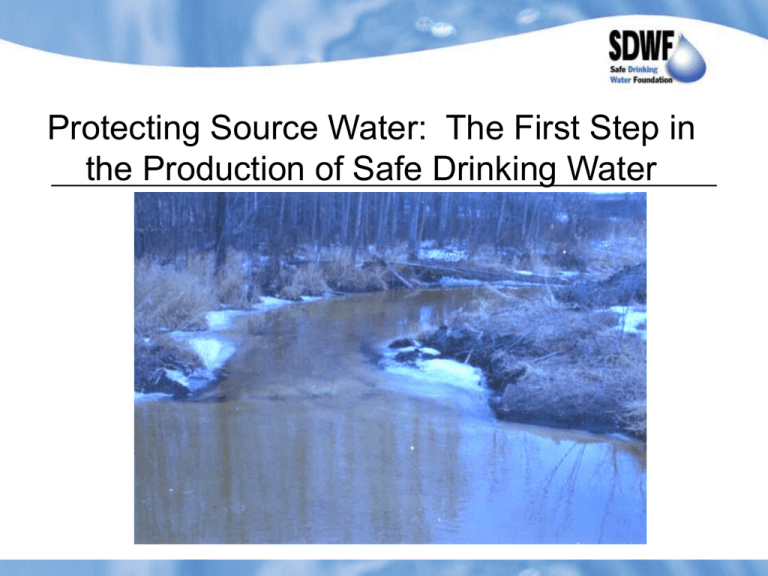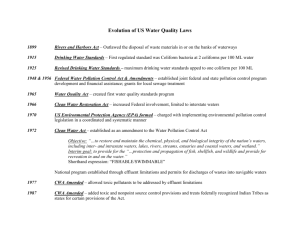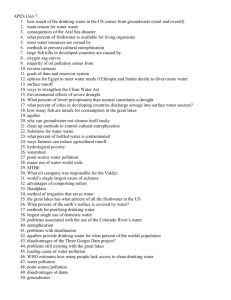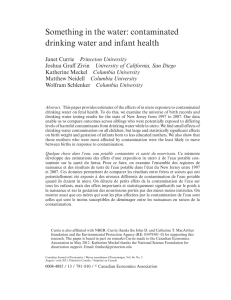PowerPoint - Safe Drinking Water Foundation
advertisement

Protecting Source Water: The First Step in the Production of Safe Drinking Water The First Step is Protecting Source Water "The first barrier to the contamination of drinking water involves protecting the sources of drinking water." - Justice Dennis O'Connor, Walkerton Inquiry 2002 Pure Water Does Not Exist in the Natural Environment Water is always found in combination with minerals and chemicals of one kind or another. Sometimes these compounds are present naturally; other times they are present as a result of human activity. Some Naturally Present Contaminants Have the Potential to Cause Harm to Humans Metals (ex: arsenic, mercury and lead) Radioactive compounds (ex: radium) Microorganisms (ex: parasites, bacteria, protozoa, toxic blue-green algae) Water can Become Contaminated with these Compounds and Microorganisms If they are naturally present in the surrounding soil or rock As a result of human activity (agriculture, industrial activity and urban development all affect the quality and quantity of surface water and ground water sources) Lack of Regulations in First Nation Communities Lacking any real regulations in First Nation communities, whatever is dumped in an unsafe manner may eventually get into the water source. Surface Runoff Some land-use activities, such as urban development, decrease the surface area available for water to filter into the ground. As a result, water simply flows across the land’s surface (called “surface runoff”) instead of recharging ground water. Source: http://www.hickerphoto.com/toronto-skyscrapers-ontario-canada-9552-pictures.htm Two Types of Surface and Ground Water Contamination Point source pollution Enters the environment at a specific place from an identifiable source Some examples of point source pollution include: • Industrial plant discharges, as well as spills and leaks of industrial chemicals • Municipal wastewater effluents • Landfill site leachate • Wastes from existing and abandoned mining sites • On-site septic systems • Leaking underground oil and gas storage tanks Two Types of Surface and Ground Water Contamination Non-point source pollution Comes from many diffuse sources Caused when water that runs over land picks up natural and human-made pollutants and deposits these pollutants directly into surface waters, or into ground water through percolation Two Types of Surface and Ground Water Contamination Some examples of non-point source pollution include: • Agricultural runoff, which can contain oil, grease, fertilizers, pesticides, bacteria and nutrients from livestock and manure • Urban runoff from buildings, streets and sidewalks that carry sediment, nutrients, bacteria, oil, metals, chemicals, pesticides, road salts, pet droppings and litter • Bacterial and petroleum products from recreational boating • Saltwater intrusion • Acid precipitation and other forms of air pollution that fall into surface waters and onto the land Preventing Contaminants From Entering Water Sources An effective way to help ensure clean drinking water for people and keep them safe from waterborne diseases. Conventional Water Treatment There are many hazardous chemicals that conventional water treatment methods cannot effectively remove. First Nation and Rural Communities While source water protection works to everyone’s benefit, it is of particular concern for rural and First Nation consumers who typically do not have the same resources as urban centres. These are the communities who struggle the most when they are forced to treat poor quality source water. Many native communities have to treat very poor quality raw water sources. Without proper treatment processes, no amount of training and regulations can make these waters safe to drink. Source Waters for Cities Source Water for Aboriginal Communities Saddle Lake First Nation Raw Water, Dissolved Organics (DOC) Saddle Lake Source Water Close-up, Note Canoe Trail that was 1.5 Hours Old Canoe Trail Anaerobic Surface Water Windy Day by the WTP The Case of Saddle Lake and Dissolved Organics Breakdown of plant and soil material: Causes water to be coloured Consumes chlorine Inhibits disinfection Forms disinfection by-products “Disinfection is only effective when applied to good quality water.” – Degremont, 1991 Combating Saddle Lake’s WaterPowdered Activated Carbon –Need Explosion Proof Room!!!! The Case of Yellow Quill First Nation Source Water A sewage tainted creek that only flowed between 5 and 14 days each spring Yellow Quill’s Raw Water Compromised by wastewater from a nearby non-native town Extreme levels of particles, >100,000/mL in treated water, levels should be less than 100/mL Extremely challenging chemistry as well Aboriginal Raw Water (left) and Urban Raw Water (right) This Aboriginal raw water on the left (from Yellow Quill) will undergo 5 minutes of treatment before it is drunk This urban raw water on the right (from Saskatoon) will undergo 2 hours of treatment before it is drunk Cost of Remediating Ground Water According to the US Environmental Protection Agency, remediating ground water can be 40 times more expensive than taking steps to protect the water at the source. Preventing contamination at the source also reduces the costs of treating water later in the drinking water treatment process. Future Water Shortages? The United Nations warns that if current trends of wasting and polluting freshwater continue, two out of every three people on Earth will suffer moderate to severe water shortages in little more than two decades. It is imperative that we take measures to protect water sources today. Source: http://environment.nationalgeographic.com/environment/photos/freshwater-threatened.html#1047_600x450.jpg Human Activities Affecting Source Water Source: www.groundwater.org What Can Be Done About the Problems? Stricter regulations Enforcement of regulations Public awareness What do you think can/should be done? What problems do you see in your community? What are you going to do about these problems? SDWF Mission • Encourage the universality of safe drinking water by supporting innovative research and development. • Increase awareness of health concerns from consumption of poor quality water. • Act as a policy advocate to ensure appropriate action is taken to provide safe drinking water to all people. Please visit us at: www.safewater.org










